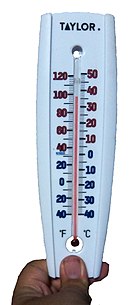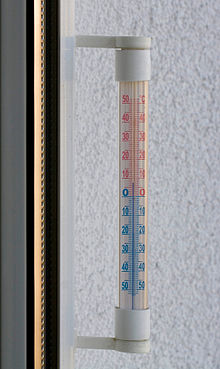Thermometer
The thermometer (from the Greek θερμός [thermos], «heat», and μέτρον [metron], «measure») is an instrument for measuring temperature. Since its invention it has evolved a lot, mainly from the development of digital thermometers.
Initially they were manufactured taking advantage of the phenomenon of expansion, so the use of materials with a high coefficient of expansion was preferred, so that, as the temperature increased, their stretching was easily visible. The substance most frequently used in this type of thermometer has been mercury, enclosed in a glass tube that incorporated a graduated scale, but also colored alcohols in large thermometers.
The creator of the first thermoscope was Galileo Galilei; this could be considered the predecessor of the thermometer. It consisted of a glass tube ending in a closed sphere; the open end was plunged upside down into a mixture of alcohol and water, while the sphere remained on top. When the liquid was heated, it rose up the tube.
The addition, between 1611 and 1613, of a numerical scale to Galileo's instrument is attributed to both Francesco Sagredo and Santorio Santorio, although the latter's responsibility for the appearance of the thermometer is accepted.
In Spain, the manufacture of mercury thermometers was prohibited in July 2007, due to their polluting effect. [citation required]
In Latin America, mercury thermometers are still widely used by the population. This is not the case in hospitals and health centers where digital thermometers are generally used.[citation required]
Temperature scales
The scale most used in most countries of the world is Celsius (°C) in honor of Anders Celsius (1701-1744) who was called centigrade until 1948. In this scale, zero (0 °C) and one hundred (100 °C) degrees correspond respectively to the freezing and boiling points of water, both at a pressure of 1 atmosphere.
Other thermometric scales are:
- Fahrenheit (°F), proposed by Daniel Gabriel Fahrenheit in the magazine Philosophical Transactions (London, 33, 78, 1724). The Fahrenheit grade is the temperature unit in the Anglo-Saxon unit of units, mainly used in the United States.
Its relationship with the Celsius scale is: °F = °C × 9/5 + 32; °C = (°F − 32) × 5/9 - Réaumur (°R), currently disused. It is due to René-Antoine Ferchault de Réaumur (1683-1757).
Its relationship with the Celsius scale is: 0 °R = 0 °C; °R = °C × 4/5; °C = °R × 5/4 - Kelvin (T)Kor absolute temperature, it is the temperature scale of the International Unit System. Although the magnitude of a Kelvin (K) unit coincides with a Celsius (°C), the zero has been fixed at the absolute zero to -273.15 °C and is unattainable according to the third principle of thermodynamics.
Your relationship with the Celsius scale is: TK= T°C + 273,15
Types of thermometers
- Mercury thermometer: is a sealed glass tube containing mercury, whose volume changes with temperature evenly. This volume change is appreciated on a graduate scale. The mercury thermometer was invented by Gabriel Fahrenheit in 1714.
- Pyrometers: thermometers for high temperatures, are used in castings, glass factories, ceramic baking ovens, etc. There are several types according to their operating principle:
- Optical pyrometer: they are based on the Wien law of distribution of thermal radiation, according to which the color of radiation varies with temperature. The color of the radiation from the surface to measure is compared to the color emitted by a filament that fits with a calibrated reotate. They are used to measure high temperatures, from 700 °C to 3,200 °C, to which sufficient energy is radiated in the visible spectrum to allow optical measurement.
- Total radiation pyrometer: they are based on Stefan-Boltzmann's law, according to which the energy intensity emitted by a black body is proportional to the fourth power of its absolute temperature.
- Infrared pyrometer: they capture the infrared radiation, filtered by a lens, using a photoresistive sensor, giving rise to an electric current from which an electronic circuit calculates the temperature. They can measure from temperatures below 0 °C to values above 2,000 °C.
- Photoelectric pyrometer: they are based on the photoelectric effect, whereby electrons of crystalline semiconductors are released when the thermal radiation incites them.
- Thermometer of bimetallic foil: formed by two metal sheets of very different and rolled dilation coefficients leaving the highest coefficient inside. It is mainly used as a temperature sensor in the thermohydrograph.
- Gas thermometer: can be at constant pressure or at constant volume. This type of thermometers are very accurate and are usually used for calibrating other thermometers.
- Thermometer of resistance: consists of a wire of some metal (such as platinum) whose electrical resistance changes when the temperature varies.
- Thermocouple: a thermocouple or thermocouple is a device used to measure temperatures based on the electromotric force generated by heating the welding of two different metals.
- Termistor: is a device that varies its electrical resistance depending on the temperature. Some thermometers make use of integrated circuits containing a thermostat, such as the LM35.
- Digital thermometers: are those who, using transducing devices such as those mentioned, then use electronic circuits to convert into numbers the small variations of tension obtained, finally showing the temperature in a viewer. One of its main advantages is that by not using mercury they do not contaminate the environment when they are disposed of.
- Clinical thermometers: are the ones used to measure body temperature. There are traditional mercury and digital, having these last few additional advantages such as easy reading, quick response, memory and some vibrant alarm models.
Special thermometers
Modified thermometers are used to measure certain parameters, such as the following:
- The balloon thermometerTo measure the average radiant temperature. It consists of a mercury thermometer that has the bulb inside a hollow metal sphere, painted in black smoke. The sphere absorbs radiation from objects from the hottest environment than air and emits radiation to the coldest, resulting in a measurement that takes radiation into account. It is used to check people's comfort conditions.
- The wet bulb thermometer, to measure the influence of moisture in the thermal sensation. Along with an ordinary thermometer it forms a cyclometer, which serves to measure relative humidity, steam voltage and dew point. It is called wet bulb because of its bulb or deposit part a cloth of cotton soaked of water, contained in a deposit that is placed next to and lower than the bulb, so that by capillaryness it is continually wet.
- The maximum and minimum thermometer is used in meteorology to know the highest and lowest temperature of the day, and consists of two instruments mounted on one device. There are also maximum or minimum individual thermometers for special or laboratory uses.
Thermograph
The thermograph is a thermometer coupled to a device capable of recording, graphically or digitally, the temperature measured continuously or at determined time intervals.
Calibration
Thermometers can be calibrated by comparing them to other calibrated thermometers or by checking them against known fixed points on the temperature scale. The best known fixed points are the melting and boiling points of pure water. (Keep in mind that the boiling point of water varies with pressure, so you have to control it).
The traditional way of putting a scale on a liquid-in-glass or liquid-in-metal thermometer was in three stages:
- Dip the sensory portion into a stirred mixture of pure ice and atmospheric pressure water and mark the point indicated when the thermal balance was reached.
- Dip the sensory portion in a steam bath to standard temperature and pressure conditions and mark the indicated point again.
- Split the distance between these marks on equal portions according to the temperature scale used.
Other set points used in the past are body temperature (of a healthy adult male) which was originally used by Fahrenheit as its upper set point (96 degrees Fahrenheit (35.6 °C) to be a number divisible by 12) and the lowest temperature given by a mixture of salt and ice, which was originally the definition of 0 degrees Fahrenheit (−17.8 °C). (This is an example of a refrigerating mix.) As body temperature varies, the Fahrenheit scale was later changed to use an upper set point of boiling water at 212 F.
Currently they have been replaced by the defining points of the International Temperature Scale of 1990, although in practice the melting point of water is used more than its triple point, the latter being more difficult to handle and, therefore, therefore restricted to the critical standard measurement. Manufacturers today often use a thermostat bath or a solid block in which the temperature is held constant relative to a calibrated thermometer. Other thermometers to be calibrated are placed in the same bath or block and allowed to come to equilibrium, then the scale is marked off or any deviation from the scale of the instrument is recorded. For many modern devices calibration will consist of indicating some value that it will be used in the processing of an electronic signal to convert it into a temperature.
Thermometers through time
Several authors have attributed the invention of the thermometer to Hero of Alexandria. The thermometer was not a single invention, but a development. Hero of Alexandria (AD 10-70) knew the principle that certain substances, especially air, expand and contract, and described a demonstration in which a closed tube partially filled with air had its end in a container with water. Expansion and contraction of air caused the position of the water/air interface to move along the length of the tube.
The following timeline shows advances in temperature measurement technologies:
- 1592: Galileo Galilei builds the thermoscope, which uses air contraction when cooling to make water up a tube.
- 1612: Santorre Santorio gives medical use to the thermometer.
- 1714: Daniel Gabriel Fahrenheit invents the mercury thermometer
- 1821: T.J. Seebeck invents thermocouple.
- 1864: Henri Becquerel suggests an optical pyrometer.
- 1870: Thomas Clifford Allbutt designs the clinical thermometer.
- 1885: Calender-Van Dusen invents the platinum resistance temperature sensor.
- 1892: Henri-Louis Le Châtelier builds the first optical pyrometer.
Further reading
- Middleton, W.E.K. (1966). A history of the thermometer and its use in meteorology. Baltimore: Johns Hopkins Press. Reprinted ed. 2002, ISBN 0-8018-7153-0. (in English)
- History of the Thermometer (in English)
- Leduc, Richard; Gervais, Raymond (1985). Connaître la météorologie (in French). Presses de l'Université du Québec. ISBN 978-2-7605-2044-8..
- Parrochia, Daniel (1997). Météores essai sur le ciel et la cité (in French). Éditions Champ Vallon. ISBN 978-2-87673-238-4..
Contenido relacionado
July (unit)
Liter
Nuclear processes









